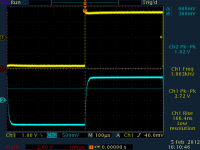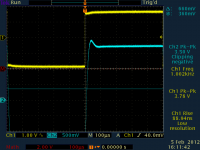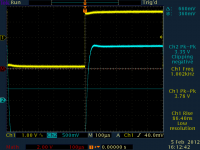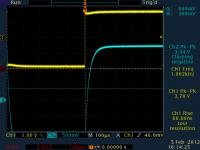I have a Krell SACD Standard for the Impasse/F4.
(The pic has a Matrix mini-i which I'm using as a D/A converter from the Krell's output (or USB input from my laptop) for playing with the amplifier in the foreground in this pic, as it has an optional digital volume control)
(The pic has a Matrix mini-i which I'm using as a D/A converter from the Krell's output (or USB input from my laptop) for playing with the amplifier in the foreground in this pic, as it has an optional digital volume control)
Attachments
To much equipment !
Hi Luvdunhill,
I see to much audio equipment on the floor, you better send me a few (F4's) to cleanup the room 😀
You can keep the KRELL I don't need that one 😀
Nice built looks beautiful 🙂
Regards,
Audiofanatic 😉
I have a Krell SACD Standard for the Impasse/F4.
(The pic has a Matrix mini-i which I'm using as a D/A converter from the Krell's output (or USB input from my laptop) for playing with the amplifier in the foreground in this pic, as it has an optional digital volume control)
Hi Luvdunhill,
I see to much audio equipment on the floor, you better send me a few (F4's) to cleanup the room 😀
You can keep the KRELL I don't need that one 😀
Nice built looks beautiful 🙂
Regards,
Audiofanatic 😉
So, with some 6SN7 tubes as they warm up I get some 60 Hz (sounding, not measured) hum. It is very strange. Some tubes start to do it and then cut in and out.. Any idea why this would be?
Also, nothing will blow up if you accidentally sub a 6BL7. It played music, but I quickly noticed and swapped it out. Heh.
Also, nothing will blow up if you accidentally sub a 6BL7. It played music, but I quickly noticed and swapped it out. Heh.
I developed some noise on one channel after it warmed up so I replaced the tubes one at a time with no change. So I started looking elsewhere, even ordered up some new FETs. After much investigation I ordered some more tubes for spares and it turned out that the 6SN7 tube solved the problem😕. Its hard to believe the first new tube I tried had the same problem in the same channel. Now months later I have another noisy 6SN7 tube on the opposite channel. Maybe I'll have to spend a little more on another manufacturer. I have limited experience with these tubes?
BDP
BDP
Interesting. I am still trying to isolate the problem, it's definitely the preamp and is clearly 60 Hz sounding... But it is tough to reliably reproduce the issue.
Any commonalities between the bad tubes? I notice that 6SN7 seem to have a wide variety of plate voltage ratings for example.. The ones I was using were old 6SN7GT and the ones I'm using now are GTAs, which have a higher voltage rating... I'll have to pull the article out to see what SY used (something special gifted by Morgan Jones? Thats what my memory says)...
I'm getting sounds in one channel. Seems to be RF of some sort. But I don't remember this happening at first..
I was using CV1988 and 5692. I also briefly tried an EH 6SN7. All worked fine. If you can't get things optimized, give me a call or come by.
I will do a test tomorrow and see if light impinging upon the cathode LED's can modulate the output of the 6SN7.
I did that with a 12AT7 a few years ago and posted it. No effect, which is totally unsurprising.
I think I have found my problem. I need more time to confirm...
Related Question: How do you determine if you have overloaded an isolation transformer? Is it total VA in each transformer divided by line voltage (perhaps with a fudge factor for losses and or headroom)?
My problem might be related to this.
Related Question: How do you determine if you have overloaded an isolation transformer? Is it total VA in each transformer divided by line voltage (perhaps with a fudge factor for losses and or headroom)?
My problem might be related to this.
One way to tell is when saturation causes the transformer to throw out an excessive 60Hz field!
isolation transformer?
Max continous load of a smaller transformer is usually around 90% +/- of the VA rating divided by secondary voltage. Larger transformers ( 1kW and upwards) usually have somewhat higher efficiency. The real ( as in complex phase angles) wattage is always lower than the VA rating -There's always both core and winding losses......
Last edited:
I am planning on trying out my Sowter 3575 and am looking to tune the RC zobel to this transformer. First, it's not even close to the Cinemag values, much more capacitance is needed (note that this is a 10K:10K transformer, where the Cinemag is 15K:15K. I just realized that, and that fact might invalidate these tests?). So, what value would you choose (or what other values would you try). Datasheet:
http://www.sowter.co.uk/pdf/3575.pdf
Setup is Tek CFG280 (50 ohm output impedance, square wave of the Pk-Pk value show at 1kHz) into two wires of transformer primary, the sheild is connected to a secondary ground. There is a center tap, that I have just left loose (good idea? bad idea?).
Image #27 shows just 100K across the secondary, which represents my stepped attenuator (the last picture, sorry cannot reorder them).
Image #28 shows just 100K || 10k across the secondary, which represents my stepped attenuator in parallel with just a 10K resistor
Image #29 shows (6.8nF + 10K) || 100K
Image #30 shows (10nF + 10K) || 100K
Image #31 shows (16.8nF + 10K) || 100K
http://www.sowter.co.uk/pdf/3575.pdf
Setup is Tek CFG280 (50 ohm output impedance, square wave of the Pk-Pk value show at 1kHz) into two wires of transformer primary, the sheild is connected to a secondary ground. There is a center tap, that I have just left loose (good idea? bad idea?).
Image #27 shows just 100K across the secondary, which represents my stepped attenuator (the last picture, sorry cannot reorder them).
Image #28 shows just 100K || 10k across the secondary, which represents my stepped attenuator in parallel with just a 10K resistor
Image #29 shows (6.8nF + 10K) || 100K
Image #30 shows (10nF + 10K) || 100K
Image #31 shows (16.8nF + 10K) || 100K
Attachments
Last edited:
While it's nice to eliminate the ringing, you have to, at the same time, be mindful of what compensation capacitance is doing to the bandwidth of the amplifier -- were the oscillographs you show done with the preamp "live" ? -- as you have to deal with the tube capacitances which affect BW. I tuned my pre with a 2x365pF variable capacitor -- and found that it was find without any compensation.
Nope, not live. I assume you still put a resistor across the volume pot in magnitude to result in the secondary inpedance of the transformer? I could definitely do it live I guess, but measuring bandwidth would be tricky as I don't have all the bits and pieces ready to do that. Good points of course, I appreciate that.
Then try using 10kHz as the fundamental, rather than 1kHz.
You can use one of the freeware FFT/soundcard programs -- or get the little FFT plug in module for your scope. The new line comes with FFT built in , but the older ones (I have a TDS3012B) need the TDS3FFT.
You can use one of the freeware FFT/soundcard programs -- or get the little FFT plug in module for your scope. The new line comes with FFT built in , but the older ones (I have a TDS3012B) need the TDS3FFT.
- Home
- Amplifiers
- Pass Labs
- ImPasse Preamplifier





